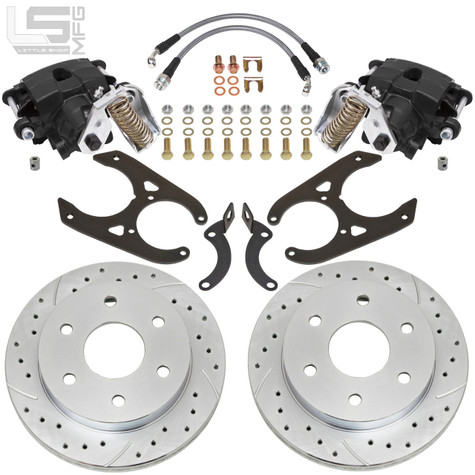Wouldn't have believed you until I looked them up. Checking several example pics on Rock for the 10" drum shoes, I see what you mean.
Scary, isn't it?
I guess I've been lucky to have never owned one that had that crummy setup.
Yup.
Pictured here in an example of wheel cylinder failure leaking fluid all over the brakes, you can see the difference in the leading shoe to the right, which is facing the front of the truck. That's on a 9.5" 14 SF though..
You must be registered for see images attach
^^^ 11.x inch Duo-Servo brakes. Primary shoe is shorter, softer, thicker, often lighter-colored. Secondary shoe is longer, harder, thinner, generally dark-colored. The purpose of the primary shoe is to cram the secondary shoe into the drum harder than the hydraulic system alone can. This is called "self-energizing". If it's TOO effective, the brakes lock up. If it's MUCH TOO EFFECTIVE, the brakes stay applied when you pull your foot off the brake pedal. Happens more often when the brake return springs get weak, AND the shoes get contaminated with brake fluid or gear lube.
Since you’re already behind the 8 ball with JB5, you have to have it all in spec with good parts to even have a chance.
You must be registered for see images attach
Leading/Trailing shoe brakes. The leading shoe does almost all the braking going forward. The trailing shoe does almost all the braking in reverse. Guess which shoe tends to wear-out faster. Thus
some Leading-Trailing shoes having more material on the front shoe.
This design is also self-energizing in that the main braking shoe (front going forward) is dragged "down" by the rotation of the drum and wedges into place based on the geometry of the anchor points. The less active shoe (rear shoe when going forward) tends to get wedged "upward" by the rotation of the drum, which helps braking power directly, but also pushes on the more-active shoe through the wheel cylinder hydraulics.
Same deal--if the shoes get contaminated, the self-energizing action can make the wheel skid, or the brakes fail to release.
GM, Ford, Chrysler, and AMC went
decades using Duo-Servo brakes on their main fleet of vehicles. Why they switched to Leading/Trailing drums on smaller cars, I have no genuine knowledge.
My best guess it that they needed some design that would work for a park brake, but NOT work as well on the back of wrong-wheel-drive vehicles so they didn't overpower the lightly-loaded rear tires leading to a skid. The GM "X" body (Citation, and clones) had problems with the park brake power vs. service brake power--if the shoes were aggressive enough to hold the vehicle when the park brake was set, they would lock the wheels in a panic stop. Folks died.
How the leading/trailing design was approved for a pickup is probably similar--when unloaded, all the weight is up-front like a wrong-wheel-drive vehicle. Overly-aggressive rear brakes would make the back end skid, and that's never good unless you're TRYING to spin the vehicle.
But all that is just a guess, and maybe not even a good guess. I wasn't there when the engineers and cost-accountants did their thing.



